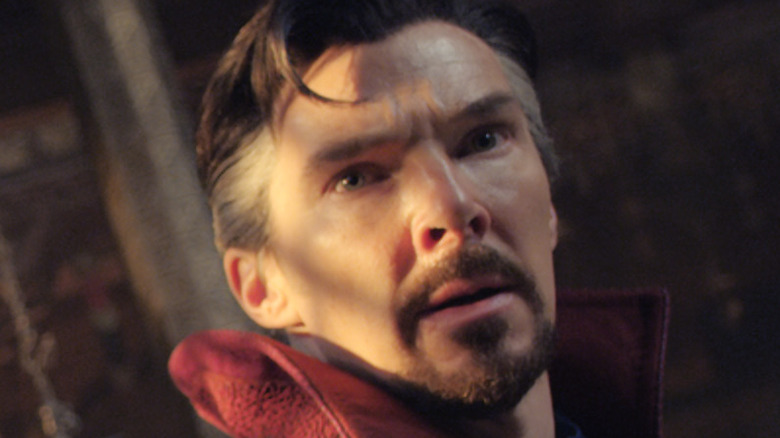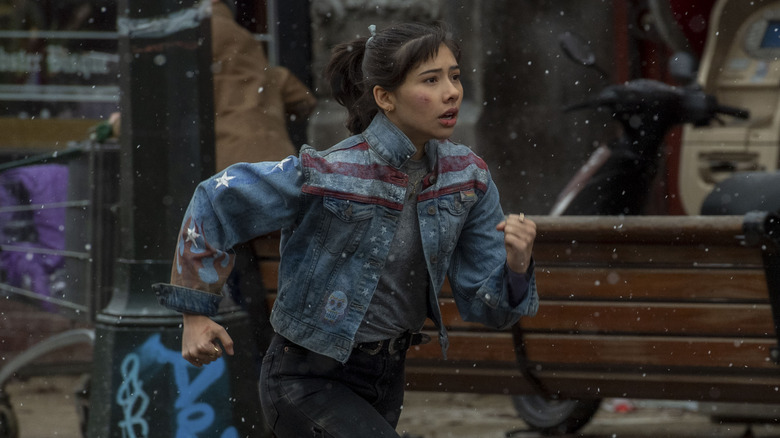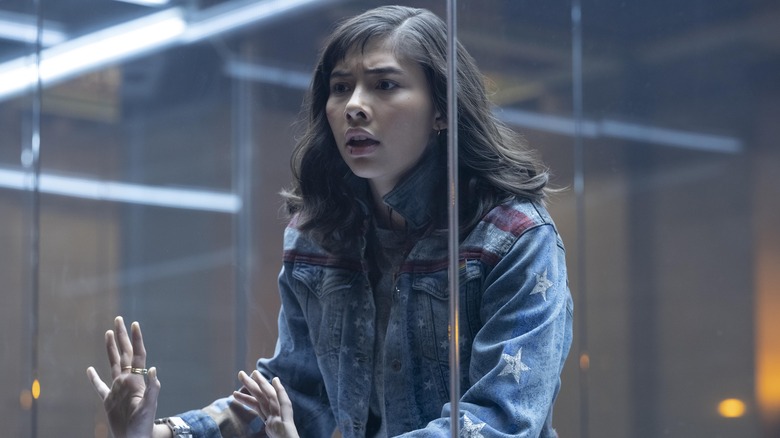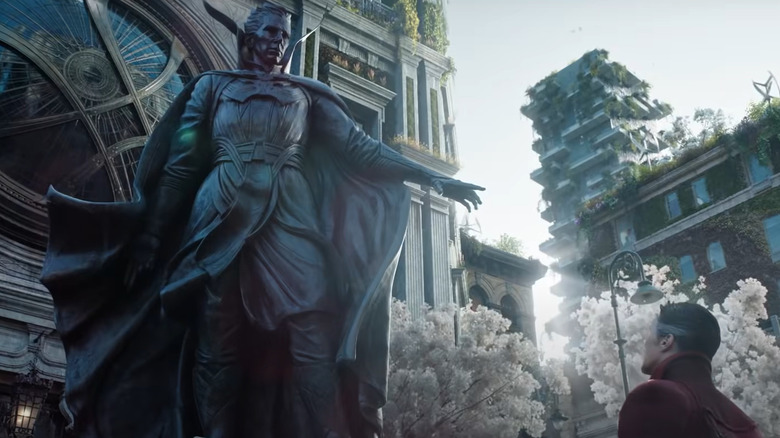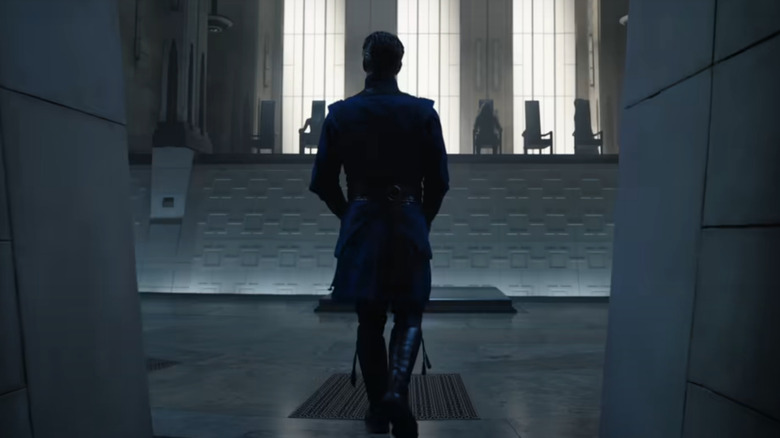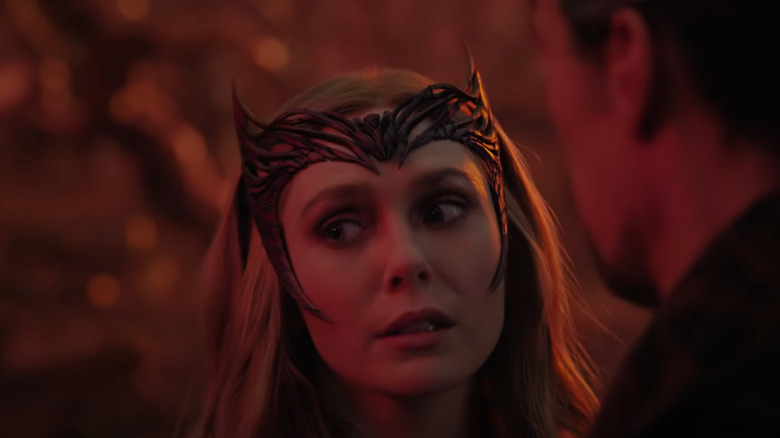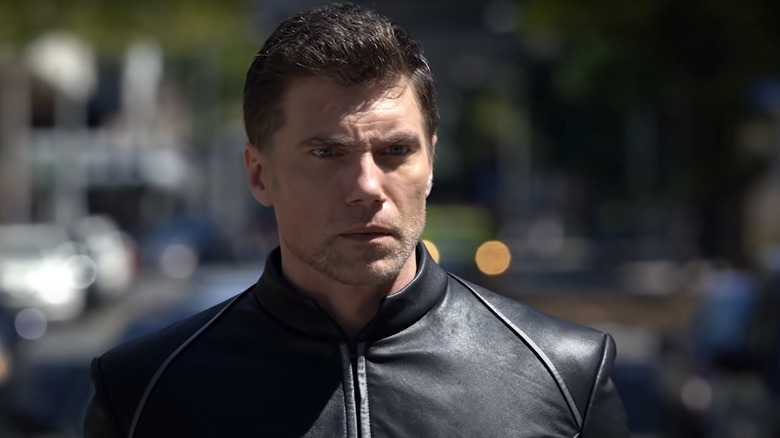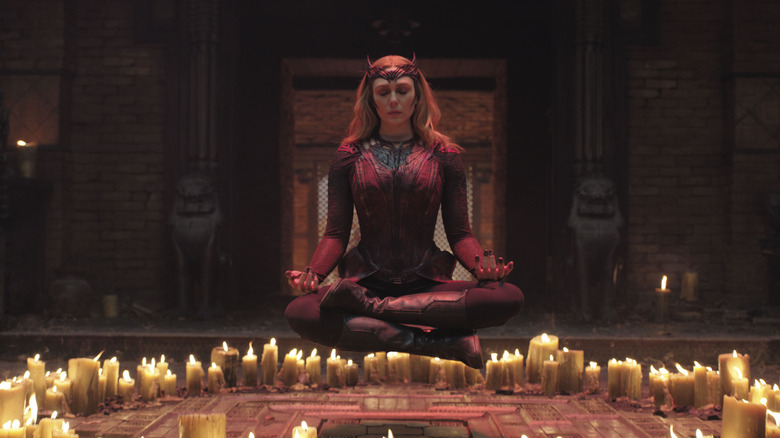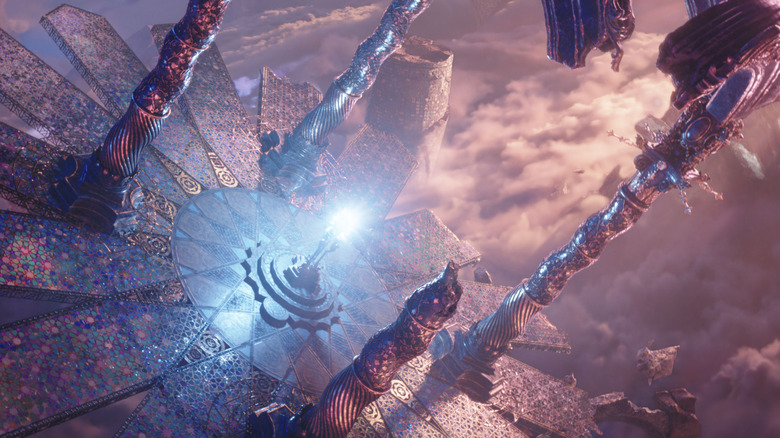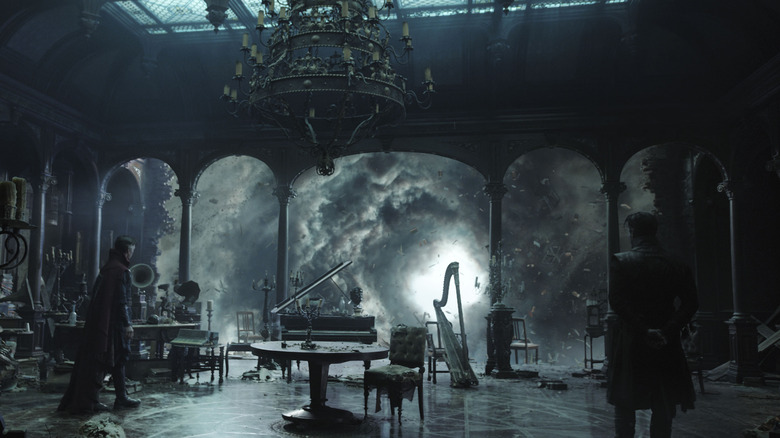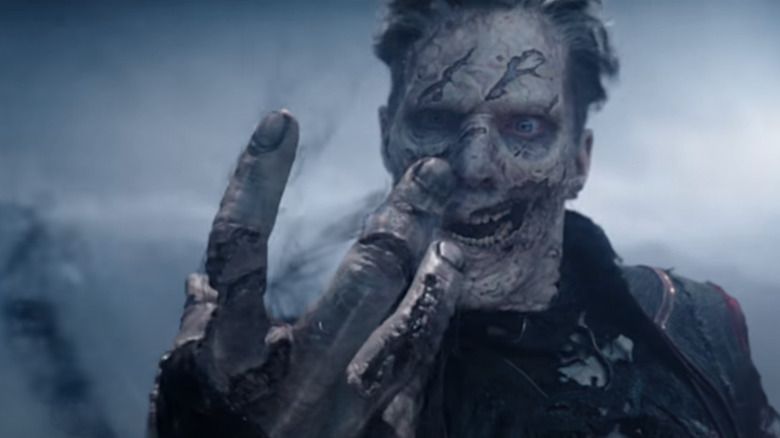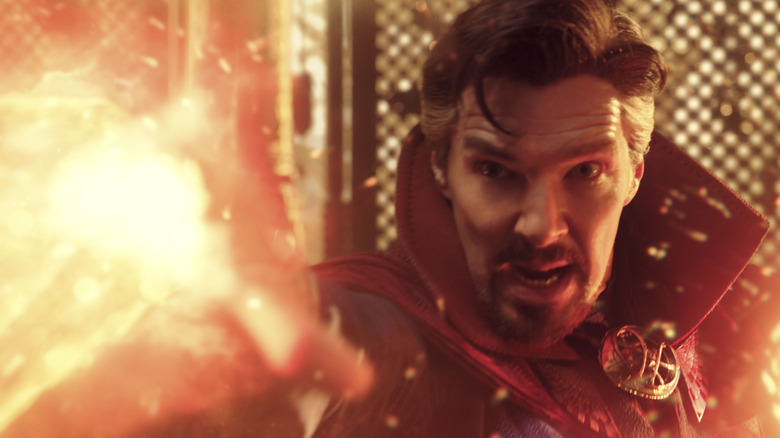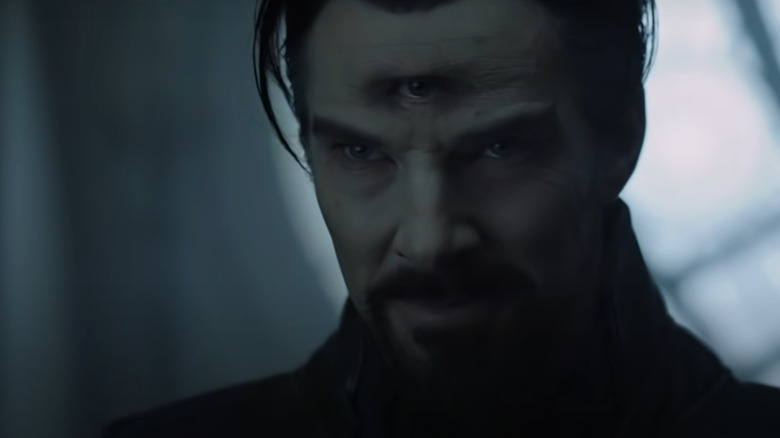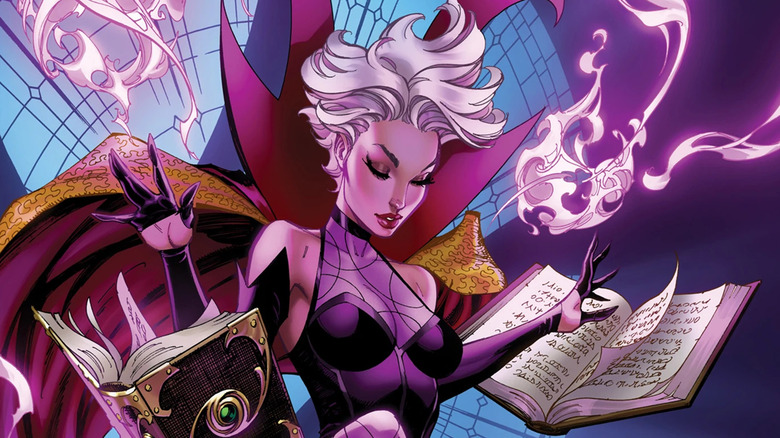Confusing Moments In Doctor Strange In The Multiverse Of Madness Explained
"Doctor Strange in the Multiverse of Madness" isn't your typical Marvel Cinematic Universe film. Under the direction of horror movie legend Sam Raimi, Stephen Strange's second eponymous MCU outing becomes an unsettling mystical adventure that's equal parts occult and science fiction. That unique fusion leads to some truly breathtaking moments, but it can also make the film more than a little bit confusing at times.
Given the subject matter, that's more than fair. Magic and the multiverse are two of the most amorphous and ill-defined subjects in the entire franchise, and they also happen to be the two cornerstones of the story. The film does a decent job of explaining its main story beats and fleshing out the lore of the MCU in the process, but part of the fun of a story like this one is in the things left up to viewer interpretation. Scarlet Witch and Doctor Strange are both compelling characters in large part due to the boundless nature of their powers. Similarly, the multiverse is an exciting setting for a movie because it's impossible to know what it's going to through at you next.
The end result is a film that leaves audiences with a lot of big questions hanging. Some of those are intentionally left as mysteries, but others can be at least partially answered by digging deeper into the MCU's past and the original Marvel Comics storylines. These are the most confusing moments in "Doctor Strange in the Multiverse of Madness" explained. Be warned, there will be major spoilers ahead.
America Chavez's multiverse escape
"Doctor Strange in the Multiverse of Madness" opens with America Chavez (Xochitl Gomez) and a variant of Doctor Strange (Benedict Cumberbatch) running from a fiery beast through a void-like dimension. It's a action-packed way to start the movie off, and as a result, it can be a bit difficult your first time through to fully grasp what's going on. With the information revealed later in the film, however, the film's opening starts to make a lot more sense.
Presumably, America encountered this ponytailed version of Doctor Strange during her journey through the multiverse, which she initially undertook in search of her missing parents. At some point around the time of her meeting him — though we're not told specifically when — America starts being pursued by various monsters. She and ponytail Strange manage to figure out that they're trying to take her powers, but they don't quite solve the mystery of who's behind the attacks in time. It's only revealed later that Wanda Maximoff (Elizabeth Olsen) is the one pulling the strings, as she needs America's universe-hopping powers to find her children once again.
How exactly Wanda is able to reach across dimensions to summon beasts of such immense powers isn't directly explained, but given how powerful she's shown to be with the Darkhold guiding her Chaos Magic, it's not too much of a stretch to guess. Of course, in the end, Scarlet Witch quits with the monsters and decides to do the job herself.
Why Wanda becomes evil
For any MCU fans who missed "WandaVision" on Disney+, Scarlet Witch's transition from Avenger to murderous villain might seem a bit abrupt. Even for those who did see the miniseries, her turn to the dark side is far more severe than anything glimpsed previously. In "Multiverse of Madness," Wanda's evil ambitions are revealed when she's asked by Doctor Strange to help America. Little does he know that she's the one endangering the poor girl in the first place.
Essentially, Wanda's obsessive use of the Darkhold — the Book of the Damned — since the end of "WandaVision" has poisoned her grief over time and turned it into a violent need for control at any cost. The film later reveals that her personality has practically been split in two between her original self and her corrupted Scarlet Witch persona. It might seem like a bit of a jump (especially given how many people Wanda kills through the rest of the film), but that's just the power of the Darkhold on display.
There are some other consuming things about this particular scene, however. For instance, Wanda creates an entire elaborate illusion of a thriving orchard to fool Strange into thinking she's left her magic behind her. He only notices the deception when she says America's name, which she should have no way of knowing. It's a baffling slip-up for such a powerful and cunning character, and it raises the question: Was the mistake an instance of the real Wanda's personality shining through?
America Chavez's childhood flashback
After arriving in Universe 838, Doctor Strange and America Chavez encounter a (conveniently accessible) scanner that recalls and displays important memories. Stephen's involves his relationship with Christine Palmer (Rachel McAdams), and America's shows a tragic moment from her childhood — the first time her portal-opening powers manifested, accidentally sucking her mothers into an unknown dimension.
In the film, the memory is mostly used to build a bit more of an emotional foundation for America, establishing both her grief and her drive to find her parents. However, the context surrounding her upbringing isn't really touched on. In the comics, America is born in a dimension called the Utopian Parallel — a world that exists beyond the reaches of the multiverse and the regular timestream. During a potential cataclysm that had nothing to do America herself, her moms made a noble sacrifice to help protect their home.
Obviously, the MCU is already diverging from that version of the story in some big ways, but from what's glimpsed of America's old home in the movie, it seems like a lot about her origin may be the same. The Utopian Parallel's existence outside the multiverse could explain why America doesn't dream or have any other variants. Even more interesting is the fact that, in the comics, the Utopian Parallel is sustained by the power of the Demiurge, an all-powerful being who happens to be the final form of Wanda Maximoff's son Billy, AKA Wiccan. It seems that America's connection to the Scarlet Witch could be just beginning.
Universe 838
"Doctor Strange in the Multiverse of Madness" spends a lot of time in Universe 838, where Earth is secretly guided by the powerful Illuminati and Thanos was defeated with the mystical Book of Vishanti. There are a lot of little details and Easter eggs sprinkled throughout the alternate dimension that are easy to miss, but they provide a lot of important context to the state of that particular universe.
While 838 isn't a major designation into he Marvel Comics multiverse, the world seen in "Multiverse of Madness" pulls a lot of details from previously inked storylines. For instance, when Christine Palmer tells Stephen and America that she works for the Baxter Foundation, it's an immediate clue that the Fantastic Four exist in her universe. The Baxter Building has long been the headquarters of the iconic Marvel superhero team, and in the 2015 Fox film adaptation, the Baxter Foundation is the research group that Reed Richards, Sue Storm, and the rest of the group work for. It seems unlikely that any major details from that particular movie will be brought into the MCU (due both to its dismal reception and the recasting of John Krasinski as Mr. Fantastic), but the similarity is still worth noting.
Given that Black Bolt (Anton Mount) and Professor Charles Xavier (Patrick Stewart) are also present in Universe 838, it stands to reason that mutants and the Inhumans are both present there. In many ways, these details make 838 feel closer to the Earth-616 of the comics than the main universe of the MCU (which is also dubbed 616 in "Multiverse of Madness").
The debut of the Illuminati
Arguably the most exciting part of "Doctor Strange in the Multiverse of Madness" is the introduction of the Illuminati to the MCU. Simply having group by that name in the franchise is a big deal, as the Illuminati are supremely important to a number of major comic book storylines. Even more intriguing are the specific members of Universe 838's Illuminati, each of whom has a unique point of origin. Due to the time constraints of a single film, these backstories aren't explored, leaving some potential confusion for those not intimately familiar with ever nook and cranny of Marvel's cinematic past.
Captain Carter (Hayley Atwell) is an alternate version of Captain America first glimpsed in the MCU in "Marvel's What If...?" Season 1. In that story, Peggy Carter ends up taking the super-soldier serum instead of Steve Rogers due to complications during the procedure.
Anson Mount reprises his role as Black Bolt (or, more accurately, a variant of Black Bolt) from Marvel's short-lived "Inhumans" TV series, which ran for just one season on ABC.
The 838 version of Captain Marvel isn't Carol Danvers, but rather her 616 wingmate Maria Rambeau (Lashana Lynch).
Patrick Stewart reprises his role as Professor X from the non-MCU "X-Men" movies, but his golden chair and presentation are closer to both the character's original comic incarnation and the version seen in "X-Men: The Animated Series."
Last on the list (aside from Chiwetel Ejiofor Karl Mordo) is John Krasinski's Mr. Fantastic, who, while not part of the franchise previously, has been a popular fancast for years. The whole group also employs a version of Ultron that seems markedly less sinister than the one from Universe 616.
As a whole, the Illuminati in "Multiverse of Madness" serve largely the same purpose as their equivalent in the comics — guiding the world in secret toward a future that they deem to be optimal.
Wanda's arrival at Mount Wundagore
After her original copy of the Darkhold is destroyed, Wanda forces Wong (Benedict Wong) to take her to Mount Wundagore, the source of the ancient text. Wong briefly explains that the mountain was once inhabited by a demon called Chthon who carved his dark spells into the rock. When Wanda arrives, she finds what seems to be a shrine erected to the Scarlet Witch and a group of Cthulhu-esque monsters who bow at her feet.
The film provides just enough context for the scene to make sense, but there are a lot of details that are easy to miss. In the comics, Chthon is an Elder God — one of the oldest and most powerful beings in Earth's history. Chthon eventually departs Earth for a parallel dimension, but before he goes, he inscribes all the dark Chaos Magic he knows within the walls of Mount Wundagore. As an infant in the comics, Wanda Maximoff is experimented on within the bounds of the mountain, connecting her to Chthon's dark power.
It's still a bit unclear what percentage of Wanda's power in the MCU is due to her exposure to the Mind Stone, and how much was latent magical ability. Though "Multiverse of Madness" makes Chthon canon in the film franchise, it doesn't really explore his specific connection to Wanda. It's possible that the monsters at Wundagore simply detect the Chaos Magic within her and recognize her as one of their own. Until more of the Scarlet Witch prophecy is revealed, it's hard to say for sure.
The brutal death of Black Bolt
When Scarlet Witch dreamwalks into Universe 838 in pursuit of America Chavez, she quickly begins ripping a bloody path through everyone who stands in her way. He body count includes the full roster of the Illuminati, each of whom dies in brutal fashion. The first to fall in the battle is Black Bolt, who also arguably suffers the most grotesque fate.
In trying to talk Wanda down, Mr. Fantastic tells her that Black Bolt could kill her with a single word from his powerful voice. In response, Wanda seals the hero's mouth completely shut, causing him to panic. A sickening pop is then heard, and Black Bolt collapses to the ground, dead. At first, it looks like Wanda may have used another bit of magic to finish the Inhuman off, but what actually happens to Black Bolt is even more unnerving. Overcome with terror at having his mouth glued shut, he can't contain his fear and appears to scream in horror. Because that scream has nowhere to go, it ends up blowing his own brains out from the inside.
Scarlet Witch's kills on the other Illuminati members are similarly gruesome. She slices Captain Carter in half with her own shield, shreds Mr. Fantastic's elastic body into pieces, and fights back against Professor X's psychic invasion well enough to kill him from within his own mind.
Wanda's mental prison
The Illuminati's last attempt at stopping Wanda comes in the form of Charles Xavier, whose formidable telepathic abilities allow him to enter her mind in search of a way to end her rampage. What he finds within her mindscape is a cryptic and unsettling scene: A white void occupied by small piles of urban rubble. Beneath one of these piles, Xavier finds a trapped Wanda — Presumably the character's original, heroic persona that's been locked away by the Darkhold's corruptive magic. Charles tries to free her from her prison, but before he can finish the job, the Scarlet Witch's own mental powers find him and extinguish his life for good.
How exactly Wanda kills Charles is a bit unclear. Her powers aren't explicitly psychic in nature, but it's feasible that her Chaos Magic could manifest in more cognitive ways. Fans of the "X-Men" movies may get some flashbacks to the Dark Phoenix storyline, which also revolves around a red-hued hero who falls to the dark side due to a powerful alternate persona. Xavier's attempt to save Wanda and his subsequent death perfectly mirror the events of "X-Men: The Last Stand," and it's doubtful that's a coincidence on the part of Marvel Studios.
Even though the Charles Xavier of Earth-838 ends up dying, it's cool to see his impressive psychic abilities brought to bear in the MCU. It's also interesting to see how Wanda's psychic prison mirrors trauma from her childhood, when she and her brother were trapped under rubble for days with an undetonated Stark Industries bomb. It's a great and powerful symbol of how Wanda's own fear and grief ultimately turn her to the dark side.
What happens to the Book of Vishanti?
As Scarlet Witch hunts America Chavez and Doctor Strange, they hunt for the Book of Vishanti — a ancient tome of pure, good magic that stands in opposition to the evil of the Darkhold. America nearly claims the book in the opening sequence of the movie, but she's forced to bail out into Universe 616 instead. Later on, she, Stephen, and Christine Palmer end up finding the Book of Vishanti, but just as they're about to tap into its power, Scarlet Witch destroys it.
For something that's said to be so immensely important, the Book of Vishanti certainly doesn't get to do much in "Doctor Strange 2." In the comics, the tome is crafted by three deities called the Vishanti, one of whom is Agamotto — the same figure who forges Doctor Strange's Eye of Agamotto. Not all of that lore has been officially canonized in the MCU, but a few things about the film version of the book are made clear.
First and foremost, it's implied that there's only one Book of Vishanti, as Christine claims that the dimension where the find it is a sort of nexus point between other parts of the multiverse. That would make the book fundamentally different from the Darkhold, which has numerous copies across dimensions (at least until Wanda destroys them all). It also seems likely that Doctor Strange's exposure to the text, though brief, may play into his enhanced powers later in the film. After all, the Vishanti are traditional huge supporters of the Sorcerer Supreme and company.
Sinister Strange's decimated reality
After Scarlet Witch seemingly destroys the Book of Vishanti, Doctor Strange and Christine fall through one of America's portals into a post-apocalyptic wasteland. They deduce that the realm they've entered is the result of an incursion — the cataclysmic collision of multiple universes — and the only survivor they manage to find is another variant of Strange himself. This new sorcerer proves to be quite sinister, however, leading to a magical showdown between the two doppelgangers.
The sequence can feel a bit confusing because it admittedly employs a lot of awfully convenient coincidences. How did Doctor Strange and Christine happen to fall into a universe where the Darkhold is still intact? How did that version of the Darkhold happen to be possessed by another Doctor Strange? How did they manage to find that Strange so quickly and easily in what's essentially an empty void? The film doesn't really provide satisfying answers to these questions, preferring more of a deus ex machina approach.
Though the evil Doctor Strange in "Multiverse of Madness" is a different variant, he shares some similarities with the one seen in "Marvel's What If...?" Season 1. In that story, a version of the doctor becomes obsessed with saving Christine's life, ultimately leading him to destroy his entire universe. Knowledge of the "What If...?" episode sheds a bit of light on the events of "Multiverse of Madness," as it shows how most versions of the character can easily fall down dark holes of unhealthy fixation.
Doctor Strange's necromancy powers
Earth-616's Doctor Strange ultimately defeats his sinister doppelganger in a breathtaking battle, where music and runic magic are blended together. In the aftermath, Stephen takes his evil twin's copy of the Darkhold and uses it to dreamwalk back into his home dimension, using the corpse of the Doctor Strange variant brought there with America Chavez at the beginning of the film.
The doctor explains that dreamwalking allows the caster to inhabit a dead body, but such a desperate move comes with its own unique set of consequences — condemnation by the "souls of the damned." As soon as Strange begins manipulating his zombified form, an army of ghouls appear and try to drag him ... well, somewhere. Presumably, the dead rise to confront strange because he's essentially practicing necromancy — a form of magic that's widely condemned in almost all sci-fi and fantasy franchises. Scarlet Witch receives no such visit from the damned when she dreamwalks into a living variant of herself, so it stands to reason that the ghosts are only bothered by actual necromancy.
Things get a bit more complicated, however, when Christine urges Stephen to use his mystical powers to control the souls of the damned, which he does. Whether this is an ability that's always been accessible to him or something made possible by the Darkhold is left unclear. Most likely, it's a combination of the two — something that only a powerful sorcerer could achieve through the use of dark magic.
How Scarlet Witch is defeated
From start to finish of "Doctor Strange in the Multiverse of Madness," Wanda Maximoff lives up to her potential as one of the most powerful beings in the entire MCU. She lays waste to Kamar-Taj, uses the sorcerers' own containment spells against them, spreads her consciousness across multiple realities, and calls an army of monsters and demons to do her bidding. In the end, the only one strong enough to defeat the Scarlet Witch is Wanda herself.
America punches Wanda through a portal back into Universe 838, where she comes face-to-face with the variant she previously possessed and her two children, Tommy and Billy. Seeing the looks of terror on her sons' faces breaks something within Wanda, stopping her bloody rampage dead in its tracks. She then returns to Earth-616 and proceeds to bring down the entirety of Mount Wundagore, burying the ancient dark magic within and destroying every universe's version of the Darkhold.
Wanda's about-face happens pretty quickly, but it makes sense given what's established earlier in the film. It's made clear when Charles Xavier enters her mind that the Scarlet Witch persona — corrupted by the Darkhold's magic — has basically imprisoned Wanda within her own mind. Presumably, the sight of her terrified children is enough to break Wanda free. Because the Scarlet Witch persona might quickly be able to regain power (given how strong it's shown to be), Wanda wastes no time in (seemingly) destroying herself and the Darkhold.
Doctor Strange's third eye
After defeating Wanda, saving the world, and returning home, Doctor Strange tries to get back to something resembling a normal life. That plan is upended, however, in the final scene before the first round of credits, in which Doctor Strange collapses in the middle of the street, convulsing in pain. The last shot shows a third eye open in his forehead, mirroring the one worn by his sinister doppelganger earlier in the film.
The third eye isn't explained at all in "Multiverse of Madness," which makes the last scene a good deal confusing. However, a look at the character's comic book storylines can provide a bit of enlightenment. Traditionally, the Eye of Agamotto isn't just used as a container for the Time Stone (in fact, that's never part of its function in the comics). Instead, the artifact is a powerful magical relic that grants supernatural powers of knowledge and vision, among other things. When using the Eye of Agamotto in the comics, Doctor Strange often displays a third eye, and it's likely that the one he gets at the end of "Doctor Strange 2" is caused by the same phenomenon.
It's possible that Stephen's brief exposure to the Book of Vishanti — one of the authors of which is Agamotto himself (at least in the comics) — unlocked new abilities within the eye. Alternatively, his third eye could be a side-effect of wielding the Darkhold, which would have far darker implications for the hero. The latter point is especially likely, since the evil Strange variant notes that using Darkhold exacts a heavy toll.
Doctor Strange meets Clea
"Doctor Strange in the Multiverse of Madness" has a brief but significant (and confusing) post-credits scene. While walking down the street, Strange is accosted by a purple-clad woman played by Charlize Theron, who claims that he's responsible for causing a multiversal incursion. She demands that he comes with her to fix it, and he readily agrees, opening his third eye and following her through a portal that she slashes open with a mystical blade.
The credits identify Theron's character as Clea — a name that fans of the comics will instantly recognize. In the original Marvel stories, Clea is a resident of the Dark Dimension who fights a constant battle against the evil of Dormammu. Because the ancient being is also one of Doctor Strange's primary foes, he and Clea become allies. They even get married later on in the comics, though their union eventually meets a tragic end.
The arrival of Clea to the MCU is exciting in itself, and it foreshadows the return of Dormammu in the next "Doctor Strange" film. If Clea and Stephen's MCU relationship is at all like it is in the comics, the doctor has some big things coming his way.
